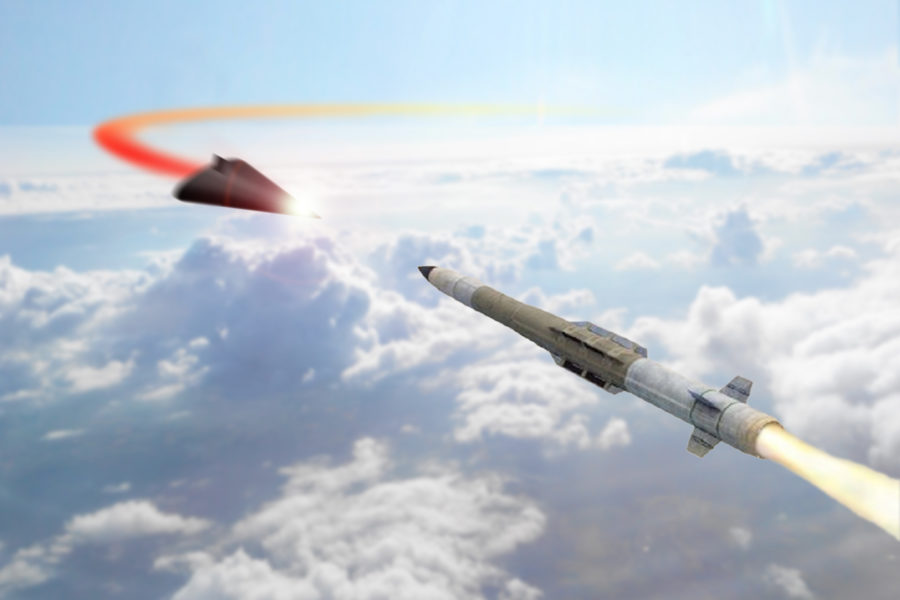A recent think tank report warns that a wave of emerging weapons such as hypersonic glide vehicles, scramjet cruise missiles, and maneuvering reentry vehicles could evade today’s missile defenses due to their high speed and unpredictable maneuvers. But unique phenomena at hypersonic speeds (about 3,800 miles per hour or faster) could also make those weapons easier to detect and track for certain sensors.
“Hypersonic weapons, the things that make them so dangerous are also what make them so vulnerable,” said Masao Dahlgren, a Missile Defense Project fellow at the Center for Strategic & International Studies and author of a new report on hypersonic missile defense, during a panel discussion Dec. 18.
“There’s a lot of work being done right now, for example, on the wakes and the plumes left by hypersonic weapons,” Dahlgren said. “These things are flying at extreme speeds through the air. The plasma that surrounds them rips molecules off of the vehicle surface. There are chemical reactions that may release novel wavelengths of light.”
Tools for detecting those wavelengths could be helpful additions to the military’s growing network of space-based sensors for missile warning (detecting missile launches), tracking (tracking missile trajectories), and fire control (guiding interceptors to a threat).
Today, the U.S. uses a mix of space- and ground-based sensors to detect and track missiles. The Space Based Infrared System (SBIRS) and Defense Support Program (DSP) satellites provide initial missile warning and early tracking, which kicks off “a sophisticated network of ground and maritime radars to determine the positions, trajectories, and signatures of ballistic missiles,” Dahlgren wrote.
The information from those sensors must be fused together into a single picture to identify how many missiles have been launched, where they are, and where they are going, all necessary information for defeating them.
“The whole story of this starts with sensors. They drive every other piece of the puzzle when it comes to designing these constellations,” Dahlgren said Dec. 18. “Better sensors mean cheaper interceptors.”

The problem is that emerging weapons technologies could evade current sensors. The limits of Earth’s geometry mean that new classes of hypersonic missiles could fly under the radar horizons of ground- and maritime-based radars, Dahlgren wrote. To detect those threats, the military is spending billions of dollars to launch space-based sensors for missile warning and tracking. It is also developing more space-based sensors for fire control.
On Dec. 20, the Space Development Agency approved the design and production plan for defense contractor L3Harris to build 16 satellites for detecting and tracking hypersonic missiles in low-Earth orbit. The announcement comes about three weeks after the Space Force completed a critical design review for six missile warning and tracking satellites that will occupy medium-Earth orbit (MEO) starting in late 2026. Before the end of the decade, the service envisions more than 90 missile warning and tracking satellites in LEO and 27 in MEO.
Those lower orbits will complement a pair of Next Generation Overhead Persistent Infrared satellites flying high overhead in geosynchronous orbit and two more in highly elliptical orbits over the north and south poles.
Historically, the U.S. has used infrared sensors to detect thermal signatures of missiles from space, Dahlgren wrote. That works great for detecting the large, hot exhaust plumes of a missile launch, but the infrared signatures of hypersonic weapons diminish beyond the boost phase, he explained.
“Distinguishing a hypersonic heat signature against the Earth’s background has been likened to tracking ‘a slightly brighter candle in a sea of candles,’ requiring extensive testing to validate,” Dahlgren wrote.

To make things more difficult, a hypersonic missile is so small that it may not be easily found among the pixels on a sensor’s focal plane array, Dahlgren said. Using sensors with a wider field of view covers a larger portion of the Earth’s surface, but it may sacrifice the fidelity needed to track a missile and provide fire control—just one example of the many tradeoffs of designing a sensor architecture.
One way to cover blind spots in that architecture could be to explore new technologies for spotting the unique signatures of hypersonic missiles. These could include hyperspectral or ultraviolet sensors capable of spotting the “wake of ions, gases, particles, and other chemical byproducts” released when the surface of a hypersonic object reacts with high-temperature airflow, Dahlgren wrote. Radar could be another alternative sensor, and it may even be possible to intercept radio emissions from data-linked missiles, he added.
Infrared sensors will be able to take higher-resolution images as technology improves, Dahlgren said, but a diverse mix of sensors could help ensure that nothing slips through the cracks.
“Combining these multiple types will allow greater persistence and capability if one type is degraded, whether from environmental conditions, enemy deception, or other means of signature reduction,” he wrote. “While it may be possible to evade one part of the electromagnetic spectrum, it is harder to evade several of them.”
“There’s more than one way to get at this problem and that’s something that I hope will receive more emphasis and will be a contribution of this report,” Dahlgren added at the panel discussion.
New threats and sensors are developing at a fast pace, which means the military needs the policies and support to keep up with those changes, said Army Col. Alexander Rasmussen, chief of the Tracking Layer at the Space Development Agency.
“Sometimes we focus on developing the tech, but we need the changes in the policy, we need the changes in acquisition, to support a very responsive approach, a spiral development,” he said at the panel discussion. “How can we change the institutions and the cultures to have that almost wartime focus now, so that we’re not surprised later, is what we really need to get after.”
